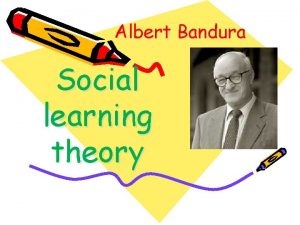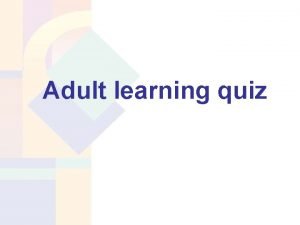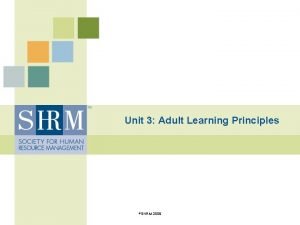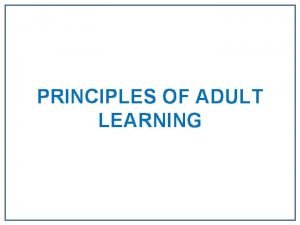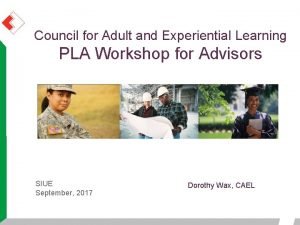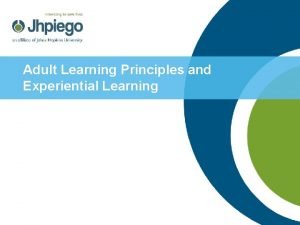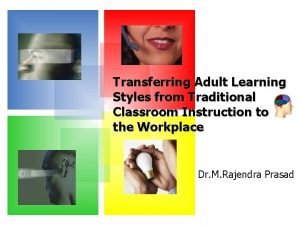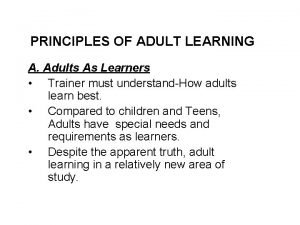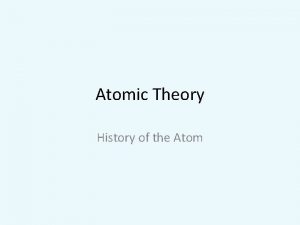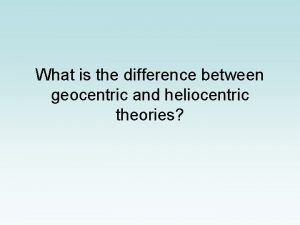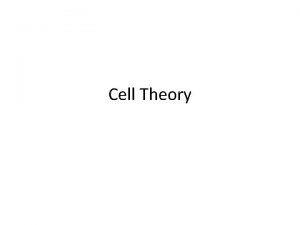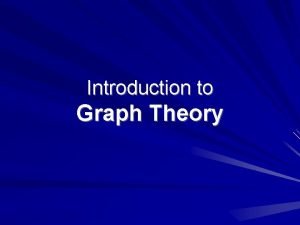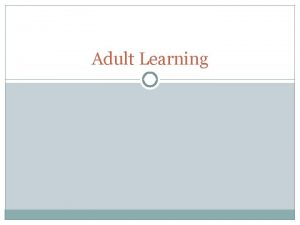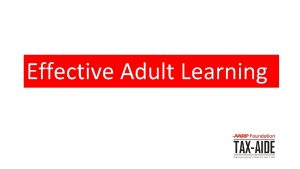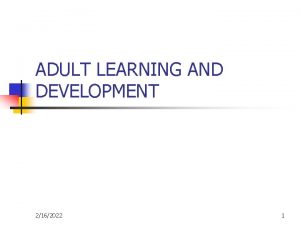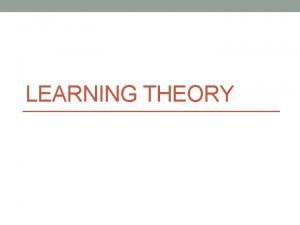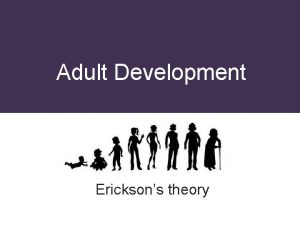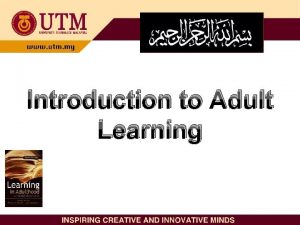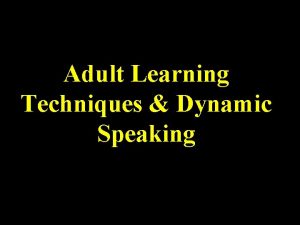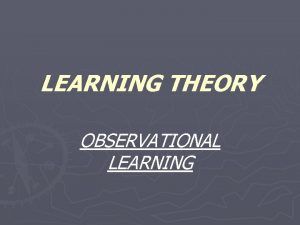Adult Learning History of Adult Learning Theory From














- Slides: 14

Adult Learning

History of Adult Learning Theory: From “Whatagogy? ” to Andragogy 1. The Meaning of Adult Education by Eduard Lindeman in 1926 marked the beginning of adult education as a field. 2. Adult educators began to look for a unique adult education knowledge base. 3. European adult educators began to use the term andragogy in the 1950 s.

History of Adult Learning Theory: From “Whatagogy? ” to Andragogy 4. Andragogy finally surfaced and became part of the educational language in 1967 with Malcolm Knowles, a prominent scholar in the field of adult education. This is what Knowles has to say as the rest of the story unfolds. . .

¡…in 1967 I had an experience that made it all come together. A Yugoslavian adult educator, Dusan Savicevi, participated in a summer session I was conducting at Boston University. At the end of it he came up to me with his eyes sparkling and said , “Malcolm, you are preaching and practicing andragogy. ” I replied “Whatagogy? ” because I had never heard the term before. He explained that the term had been coined by a teacher in a German grammar school, Alexander Kapp, in 1833… The term lay fallow until it was once more introduced by a German social scientist, Eugene Rosenstock, in 1921, but it did not receive general recognition. Then in 1957 a German teacher, Franz Poggeler, published a book Introduction Into Andragogy: Basic Issues in Adult Education. . .

Andragogy Defined 1. The term andragogy is based on the Greek word andragogos (with the stem andr-) meaning ‘man not boy’ (Plato’s idea that adults continue to learn) 2. Knowles defines andragogy as the art and science of helping adults learn in contrast with pedagogy, which concerns helping children learn 3. Is

Theory ¡“A theory is a set of interrelated concepts that explain some aspect of the field in a parsimonious manner” (Merriam & Caffarella, 1989)

Learning Theory: Four Major Lenses 1. Behaviorist--People’s behavior is a collection of habits. Individuals learn through positive reinforcement and negative reinforcement. (Thorndike, Watson, & Skinner) 2. Subject-Centered—Primary teaching function is the selection of “lesson plans” containing the content and “right” answers. (Locke, Herbart & Hirsch)

Learning Theory: Four Major Lenses 3. Constructivist—Knowledge is not simply “out there” to be attained; it is constructed by the learner. 4. Student Centered--students’ interest and needs must be integrated with subject demands—meaningful learning takes place as the abstract world of concepts connects to the real world of personal experience (Dewey)

Six Assumptions of Andragogy According to Knowles 1. Need to learn: Adult learners are driven by cognitive needs. They ask higher level questions of “Why” “What” and “How”. 2. Self-Concept: Adult learners are directing their own plan. (teacher directed vs. self directed) 3. Experience: Adult learners bring an ever growing reservoir of experience and knowledge to the table. The traditional concept of the “tabula rasa” or blank slate does not apply to the adult learner.

Six Assumptions of Andragogy According to Knowles 4. Readiness to learn: Adults are focused and ready in a highly pragmatic way. Adults want to learn those things that will have a direct impact on themselves, their family, and/or work. 5. Orientation to learning: Problem centered rather than subject centered. 6. Motivation: Adult learners are learning for a reason, and they push themselves from within. They are sparked by an inner source and have a sense of urgency about their learning. (internal vs. external motivation)

Four Supporting Assumptions according to Dirkx, Lavin, and Pelavin (1995) 1. Diverse, active learners: wealth of experiences 2. Problem-oriented: pragmatic learners, seeking to improve their performance 3. Control of their own learning: voluntary learners who take seriously their decision to return to school. 4. Strong sense of self: varying degrees of selfefficacy, but sense of self plays a major role in their learning

Adult Learner Roles 1. Caretaker: Do we need a break? 2. Know-it-All: A comment for every idea and is willing to share 3. Hitchhiker: Passive learner, along for the ride 4. Blocker (Devil’s Advocate): Contrary positions in the discussion

Adult Learner Roles 5. Parliamentarian: “Haven’t we extended our rule about time limits for group presentations? ” 6. Sage: Formal and informal power in the group 7. Clown: Brings levity to the scene, humor to diffuse mounting conflict

The Message “To touch one’s sprit requires that the teacher be grounded in understanding the student’s history, language, culture, and lived experiences. In order to help the learner reach his or her potential in the learning environment, the teacher must make a connection to the affective and spiritual as well as the cognitive domains” (Alfred, p. 45).
 History of albert bandura
History of albert bandura Adult learning pyramid
Adult learning pyramid 7 principles of adult learning
7 principles of adult learning For adult
For adult Council for adult and experiential learning
Council for adult and experiential learning Brookfield adult learning
Brookfield adult learning Adult learning principles
Adult learning principles Adult learning styles
Adult learning styles Adult learning definition
Adult learning definition Cuadro comparativo e-learning b-learning m-learning
Cuadro comparativo e-learning b-learning m-learning Also history physical
Also history physical History of atomic theory
History of atomic theory Geocentric model and heliocentric model difference
Geocentric model and heliocentric model difference Wacky history of cell theory
Wacky history of cell theory Origin of graph theory
Origin of graph theory
